The Ivy Bridge Preview: Core i7 3770K Tested
by Anand Lal Shimpi on March 6, 2012 8:16 PM EST- Posted in
- CPUs
- Intel
- Core i7
- Ivy Bridge
Discrete GPU Gaming Performance
Gaming performance with a discrete GPU does improve in line with the rest of what we've seen thus far from Ivy Bridge. It's definitely a step ahead of Sandy Bridge, but not enough to warrant an upgrade in most cases. If you haven't already made the jump to Sandy Bridge however, the upgrade will do you well.
Dragon Age Origins
DAO has been a staple of our CPU gaming benchmarks for some time now. The third/first person RPG is well threaded and is influenced both by CPU and GPU performance. Our benchmark is a FRAPS runthrough of our character through a castle.
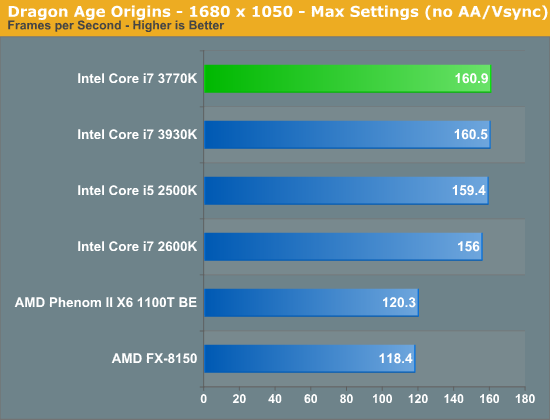
Dawn of War II
Dawn of War II is an RTS title that ships with a built in performance test. I ran at Ultra quality settings at 1680 x 1050:
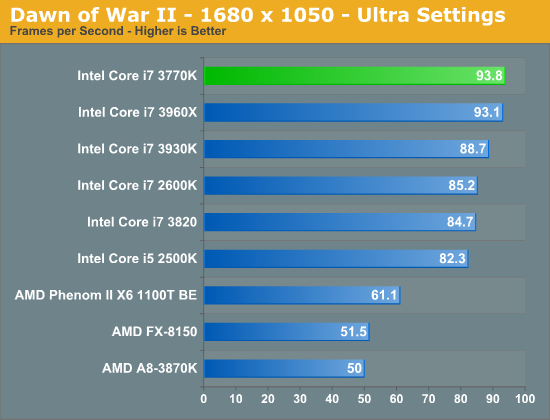
World of Warcraft
Our WoW test is run at High quality settings on a lightly populated server in an area where no other players are present to produce repeatable results. We ran at 1680 x 1050.
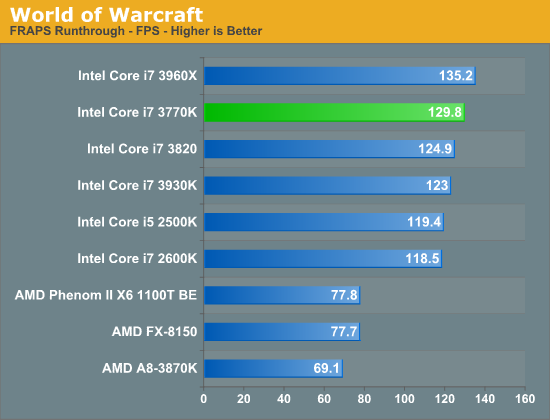
Starcraft 2
We have two Starcraft II benchmarks: a GPU and a CPU test. The GPU test is mostly a navigate-around-the-map test, as scrolling and panning around tends to be the most GPU bound in the game. Our CPU test involves a massive battle of 6 armies in the center of the map, stressing the CPU more than the GPU. At these low quality settings however, both benchmarks are influenced by CPU and GPU. We'll get to the GPU test shortly, but our CPU test results are below. The benchmark runs at 1024 x 768 at Medium Quality settings with all CPU influenced features set to Ultra.
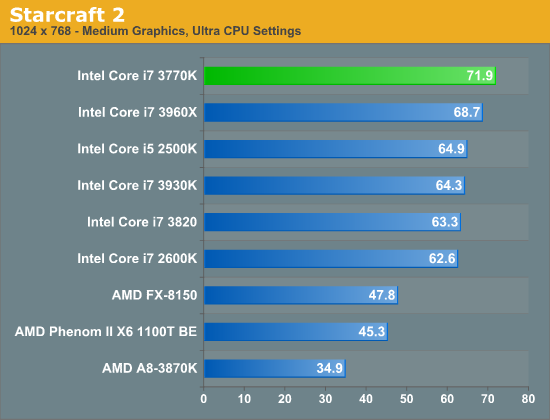
Metro 2033
We're using the Metro 2033 benchmark that ships with the game. We run the benchmark at 1024 x 768 for a more CPU bound test as well as 1920 x 1200 to show what happens in a more GPU bound scenario.

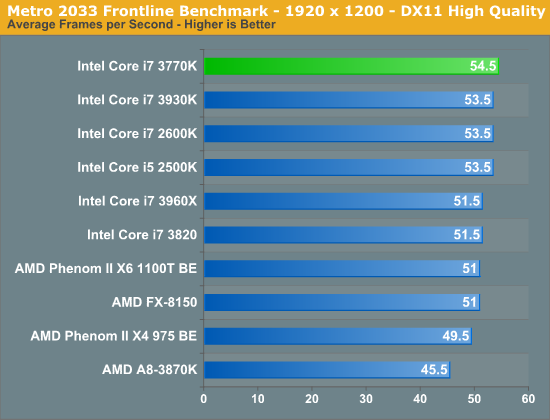
DiRT 3
We ran two DiRT 3 benchmarks to get an idea for CPU bound and GPU bound performance. First the CPU bound settings:
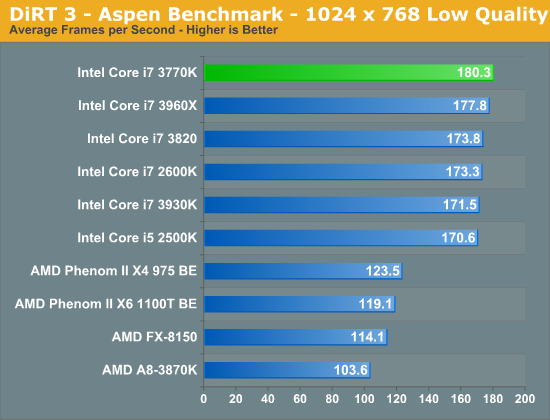
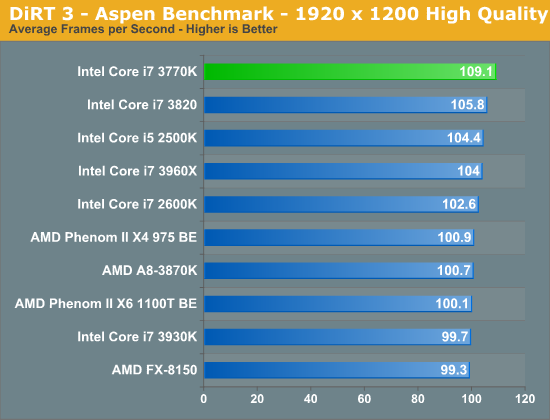
Crysis: Warhead
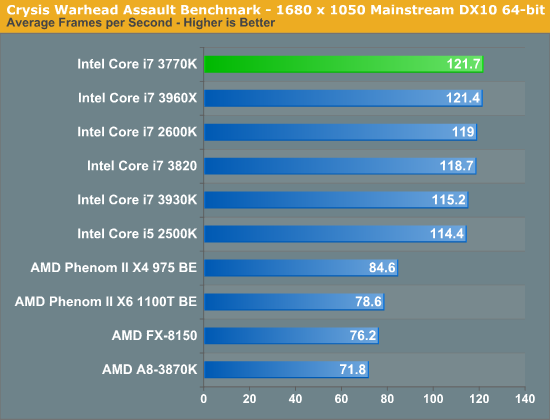
Civilization V
Civ V's lateGameView benchmark presents us with two separate scores: average frame rate for the entire test as well as a no-render score that only looks at CPU performance. We're looking at the no-render score here to isolate CPU performance alone:
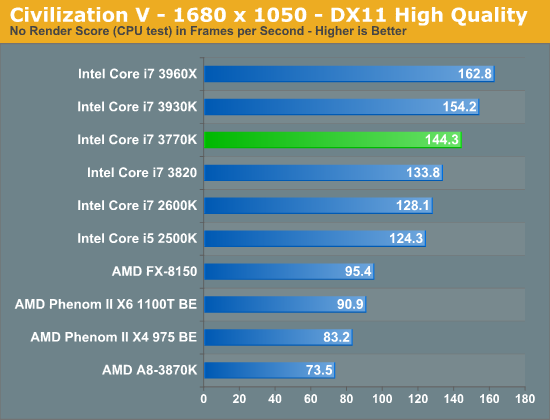










195 Comments
View All Comments
Zoomer - Wednesday, March 7, 2012 - link
It would have been interesting to see. Personally, I don't care for IGP, as they sit disabled anyway. Right now, it seems like it's a 7% clock for clock perf increase, which is very poor for one process node. Knowing where the clocks can be will let everyone know exactly how much faster the CPU can be over SB.NeBlackCat - Wednesday, March 7, 2012 - link
For me, the most interesting things about IVB are improved multi-monitor support, and power savings not just at stock, but also undervolted (stock clock) and overclocked.Because I want to know if I'm finally going to get that laptop or mini-itx system that can drive several monitors while remaining cool and sipping power, even under load.
Not covered at all. Shame.
beck2050 - Wednesday, March 7, 2012 - link
Intel marches on. Their domination of 80+% of all CPU markets will continue.silverblue - Wednesday, March 7, 2012 - link
PC and especially server market, sure, but not smartphone/tablet. Not yet, anyway.fvbounty - Wednesday, March 7, 2012 - link
Should have a had SB 2700K to run clock for clock against the 3770K and see if there's much difference!ellarpc - Wednesday, March 7, 2012 - link
Agreed! I was just about to post that same comment. It doesn't make much sense to compare it to a lower clocked SB product. Well unless you wanted to make the IB look better. Now I'm going to sift through anand's past reviews to see what kind of gains the 2700 has over the 2600.ellarpc - Wednesday, March 7, 2012 - link
Doesn't look like Anand has a 2700k for testingueharaf - Wednesday, March 7, 2012 - link
I was thinking that the difference in gpu perfomance between HD3000 and HD4000 about 20% to 40% increase perfomance, will remain in the ivy-bridge mobile chips!!! I hope soo!!!lilmoe - Wednesday, March 7, 2012 - link
Great review. You guys know your stuff. I've been waiting for a review like this since IvyBridge was announced.However, I'll still "cling to my Core 2" since it does the job now, and I'll postpone my upgrade till next year. You make it seem like Haswell is a good reason to wait. I bought the system in early 2010, and I usually upgrade every 2-4 years. 3 years sounds just right. I'll be investing in SSDs since you talked me into it though, it seems a better upgrade at the moment.
Breach1337 - Wednesday, March 7, 2012 - link
Did Intel specifically ask not to include overclocking tests in ES previews?